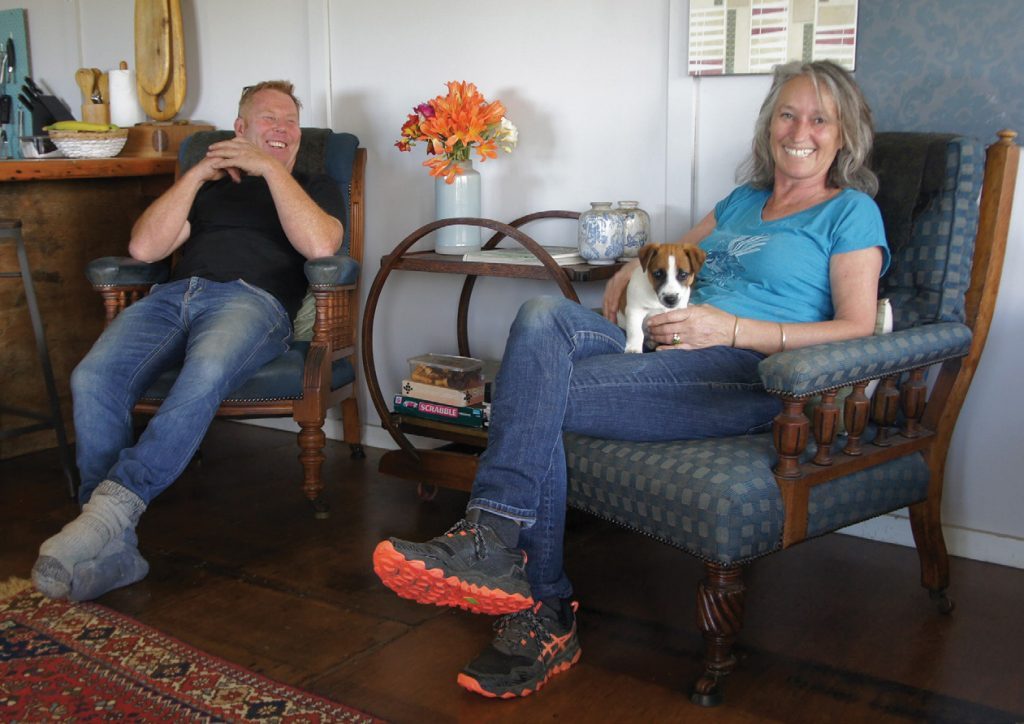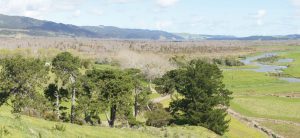Planting alongside a tributary of the Waikato River is a labour of love for a family whose ancestors have farmed the property since the 1840s. Claire Ashton writes.
Kim and Stu Muir arrive with a trailer load of trees from local nursery Farrell’s when we meet on their 200-hectare farm in Aka Aka, Southeast of Pukekohe in the Franklin District.
The Muirs, friends, family, and volunteers have planted 3000 trees this spring, along with 2500 last autumn. Planting is along the Mangati stream, a tributary of the Waikato River delta which runs along one border of the Muir farmland.
“When we got married, instead of getting Tupperware or something, we asked for trees,” Stu laughs.

The plants are unloaded next to the 54-bale rotary shed where farm manager Kyle Callaghan and 2IC Matt Farrell, have nearly completed the task of replacing the rubber tubing. Their herd of up to 500 Friesian graze pasture or use the 500-bale wintering pad/feed pad when the land is at its most vulnerable.
The farm has 40ha of stream or bush, with pocket stands of trees dating back to the beginning of the Muir ownership of the land via Stu’s father. Along the way Stu points out an old, felled totara log resting under some kahikatea, from when Hongi Hika invaded in 1821. The Muir family have been farming the land since 1842, purchased Te AkaAka farm in the 1890s, and are sixth generation farmers.
Local Iwi Ngati Te Ata and Ngati Tepi both come under the korowai of Tainui, and originally there was a tramline built to cart Harakeke (flax) to the Pa site to be processed. Waikato River Authority and Tainui Treaty Settlements means that the co-governance benefits the land and waterways. Stu is part of a group who speak only Māori when they get together and he enjoys this immensely, especially when the teenagers are around and participating.
Construction of the Arapuni dam released 65 million tonnes of silt in the 1920s, which filled up the tributaries throughout the river delta. Drains were then dug out by unemployed men during the depression and in the 1950s they further cleared a tributary out to replace the main one that came through the back of the Muirs’ farm.
Environment Waikato have been offered the bank along this man-made tributary to plant, but that work is yet to progress. Weeping willows are dotted along the banks, and provide some shade – and they don’t break off like crack willow.
“It’s all about getting the right plants in the right place, the only thing that likes willows are wasps and possums,” Stu says.
A diversity of planting is needed along the banks to mirror the work Stu has created in the wetlands as a network of smaller trees provides a more interconnected root network to stablise the banks, prevent erosion, and run-off from farmland.
Killing off the whitebait
Floodgates installed in the 1970s were good for farming – but not for the whitebait as floodgates not only restrict fish access to their upland habitat but killed the fishery on the northern banks of the river within a decade.
With no tidal inundation, the creeks stagnate over summer with huge putrid algal blooms and then in autumn and early winter, water becomes crystal clear as all the oxygen is sucked out turning the water acidic and killing all the fish.
With the wetlands now, however, there are ponds where the whitebait, part of the diverse inanga species, can come and spawn 10km inland. By opening up the floodgates over summer it will allow the system to flush with fresh water and give the whitebait an area to spawn as they did before the installation of floodgates.
The main goal is to open the wetlands boardwalk to the public so they can learn about the local wetlands environment.
Before the 2014 planting project all that was in the wetlands were pampas, glyceria and willows, and when a willow fell it just started growing again so the wetlands was choked with trees.
Stu sprayed first, chain-sawed the branches and trees and pulled them out with a digger, working around the tidal wetlands which at high tide is 4.5 metres.
The co-governance of Tainui with the Waikato River authority means they are collaborating to increase and enhance the wellbeing of the Waikato River, however he says outdated views and methods by some organisations haven’t kept up with the new environmentally sustainable way of planting for biodiversity and for the prevention of erosion along banks.
The Muir family were the first recipients of funding from the Waikato River authority, Stu, Kim and family started with a small one-hectare island to prove what could be done with $10,000 and when that proved successful, Stu says they thought, “Wow what can we do with a $50,000 grant!”
Funding for the wetlands development comes from a variety of groups including; WRA, Waikato and Auckland councils, Foundation North, Whakaupoko Landcare group and the Acclimatization Society.
“Mahoe, karamu, pukatea, kowhai, and those sorts of plants have roots that interlock which holds the bank together plus they create biodiversity. You don’t want to plant on the bank itself, apart from flax, but above the bank which also creates that buffer of riparian planting.”
The trees also shade the stream. Koromiko abound too, a traditional Māori plant used as medicine and taken overseas as a remedy for a variety of treatments during World War I.
“Nature is pretty good at designing perfect forms, “ Stu says. If you observe what grows naturally then that is a good indicator of how to plant and where. Stu was always out planting with his Dad, but more in the hundreds than the thousands they plant now. He doesn’t always get it right – there is still room for trial and error.
“Hangehange which has a shiny leaf was a bit of a mistake – as it doesn’t like being planted.”
After clearing the larger plants; willows, glyceria and pampas, the wetlands weeds to watch for are; tobacco plant, and alligator weed. Some consider the larger trees a negative, but they can act as a sub canopy and protect the plants below. Mahoe and karamu are especially important for the medium-sized growth and cover and are now growing fast as their seeds aren’t being eaten by rats, and the leaves aren’t being eaten by the possums, meaning a more uniform growth across the wetlands.
With the wetlands restored, it now provides a healthy living environment for a variety of fish species such as kahawai, koura, mullet, eels, and even kākahi, (freshwater mussels). One mussel can filter 20 litres of water a day and a healthy population could filter an entire lake. These mussels are natural water filters and aid denitrification – but of course they don’t eat them.
 Predator control
Predator control
There are 2000 bait stations, mainly in trees, and traps on the ground which were originally funded by the Waikato River Authority but are now being funded through a Landcare Group, the Whakupoko and Acclimatisation Society.
Rats, stoats, ferrets, and weasels are local pests, and there is a weasel in the bait station when we visit the boardwalk, which Stu later adds to the freezer collection which DOC sometimes utilise to track the pest predator population. When a ferret or stoat kills a rat, if the rat is poisoned then the mustelids are poisoned as well, through secondary poisoning. Other animals that disturb the ecosystem are pigs, goats and deer. Pigs root in the edges of the wetlands and disrupt bird nests.
Bird life has noticeably returned due the pest eradication programme; tui, kereru, and rails and crakes now abound – pukeko have always been abundant. Also present are up to 30 bitterns and the short-tailed bat. A couple of kotoku, white heron from the West Coast of South Island, pay a yearly visit.
Stu is particularly thrilled with the presence of the Australasian bittern/matuku which are now rare in NZ and the wetlands species population is estimated to be fewer than 1000 individuals. They’re classified as ‘Threatened-Nationally Critical’ due to introduced predators and loss of habitat.
Stu is so passionate about preserving our wildlife that he became chair of the Endangered Species Foundation, a registered charitable organisation supporting high-priority conservation projects that protect NZ’s most vulnerable indigenous species and habitats from extinction. Governance roles are something Stu relishes being part of.
“Good governance is knowing your role and not getting too mixed up with the operation and management side. As a chair, being able to listen and having a diversity of opinion around the board table is important.”
Stu likes to chair in an open manner, letting all voices be heard and tries to create an environment around the table where all can participate and share opinions. “In a leadership role you need to keep asking yourself – what is the role of your vision and strategy – and keep going back to your purpose.”
In terms of the reach of his message, there is certainly a nationwide audience, for example via the networks of the Dairy NZ Environmental Leaders Forum.
“My farm doesn’t need to look like an English garden.” Stu doesn’t go for uniformity and says farmers need to choose their enemies.
“Carex are perfect for example – but often farmers spray them.” The whole farm has been contoured, and he uses carex and reeds along the drains, which helps to filter sediment, prevent leaching and provides nesting for birds.
“When the farm is really vulnerable for a short time of the year you take the cows off the land and save all the effluent, which goes on to the crops that you then feed the cows when they are on the pad.”
“On 60% of the farm now we don’t need chemical fertiliser – that’s huge. Combined with chicory and plantain you have a better conversion rate of nitrates into protein. Maize takes out more nitrates, and then the herd are on the feed pad – so it is being captured to be used at the right time of year.”
The future is plant-based at the Muirs, and they welcome corporate events as they come out and plant trees which is both team-bonding and soil-binding. A side hustle they have had for years is the Te Papa eco-cottage, available on Airbnb and Glamping Hub USA, an eco-cottage which they admittedly used funds earmarked for their kids’ university education to build, but which now earns an income to pay for that education. The eco-cottage is an ongoing business which has been particularly helpful during the farming downturn and perches at the top of the property looking towards the east and across the 40ha wetland.
“Within hours of us putting it online it was booked and we never looked back. Now people after going through Covid really want privacy, just to get away.”





